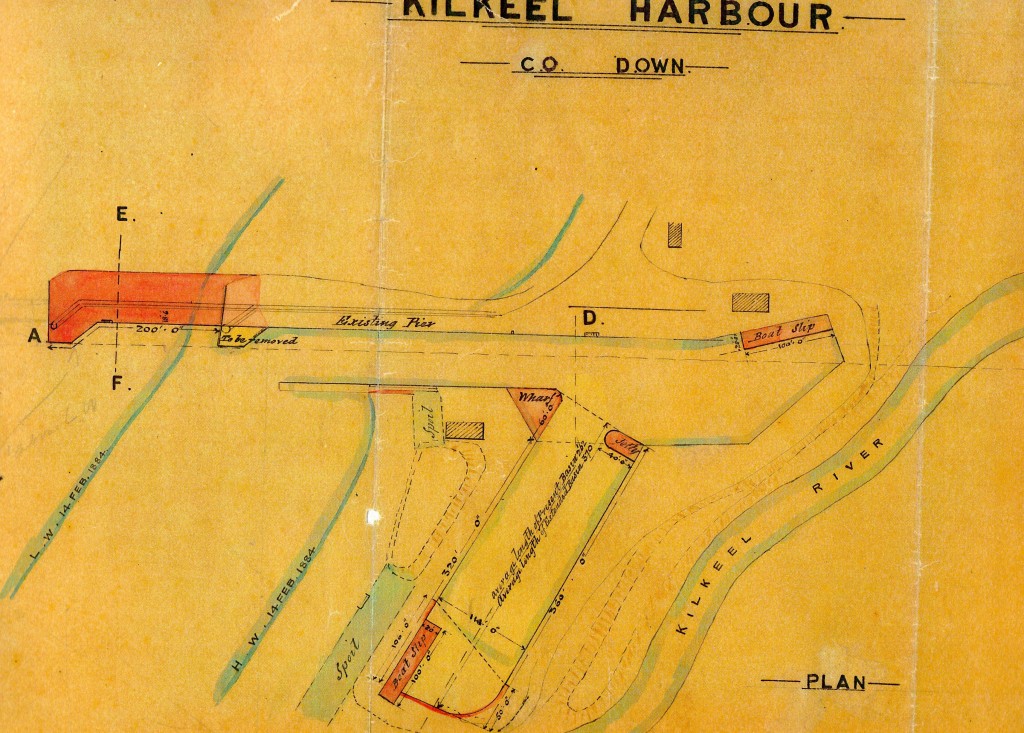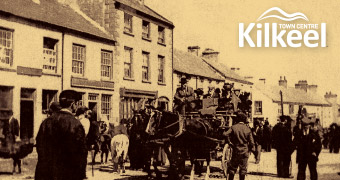Kilkeel harbour was not the central destination for ships in the 1800s. Lack of a working harbour meant that the Kilkeel fishermen beached their boats on the shore. Towards the end of the century however, work began on the harbour to extend it. This commenced in July 1885 according to the County Surveyor[1] and by the 1860s the sand bar was removed and a proper harbour and pier was completed. As a result it attracted more fishermen, therefore further improvements were needed to accommodate these new users.
With a government grant of £7000 along with local donations of £3000 the pier of Kilkeel harbour was lengthened and the harbour was enlarged in the 1870s. It was now able to accommodate 21 fishing vessels. In 1880 however, the harbour master Thomas Grills expressed concern over the increased demand for the harbour and in 1885 a further £7400 was invested on further expansion. The work was completed in 1887 and boasted a new wharf, a jetty and a deeper basin. The harbour was now fit to accommodate 100 fishing luggers. During the herring season there could be over 300 boats coming and going. Kilkeel became a very important port in Ireland and coastal traders brought in coal, along with granite, oats and timber. By 1909 12,000 tons of potatoes were landed here on a yearly basis. [2]
The files relating the extension of Kilkeel harbour can give us a good indication of the growth of the fishing industry in Kilkeel in the later 1800s. The Fishery Files between 1877 and 1912 (available from PRONI) document the processes taken by those in positions of power and influence to achieve their proposed goals. This file is quite a substantial document, full of letters and requests back and forth from different people including people like the harbour master and head of the local Coast Guard. It took a lot of effort and negotiating to actually get the plans approved…that much has not changed since then at least!
In 1883 the need for the new harbour was laid out in a document, along with the proposed changes, new plans and costs. It was headed;
‘Special points required to be reported for His Excellency’s information as required by the Under Secretary’s Letter, 23 November 1883’
The report expresses that Kilkeel has ‘long been one of the most important stations for the Herring Fishing…but as was proved last year…the accommodation for fishing boats is entirely insufficient… It is proposed…to enlarge the present harbour and lengthen it’s pier.’
- The population of Kilkeel was estimated at 1500.
- 61 boats were registered as belonging to Kilkeel but 100 English, 80 Scottish, 300 Irish and 150 Mourne boats frequented it between March and November 1883.
- 1882: capture of Herring was 6000 measures.
1883: capture of Herring was 3465 measures (due to reported bad weather)
The total realized was £3898.
- The transit to markets was also assessed expressing that Kilkeel was 3 miles from Greenore and then it followed an easy transit to London.
- Estimated cost of required works was £7400, consisting of £450 donated locally and aid totalling £1400 from the County Down Grand Jury.
Overall the document expressed a great need for the changes to the harbour, as at present it just was not capable of accommodating the growing fishing industry.
Below is a map of the proposed changes to Kilkeel Harbour, dated 1884;
After the new changes were made there still seemed to be problems. In 1894 a letter sanctions an expenditure of £800 for repairing Kilkeel Harbour from the Secretary of Fisheries Office. In August 1910 there are further complaints about the accessibility of the harbour from the Station Officer of the Kilkeel Coast Guard, George Shaw. He complains that the fishing is not as good this present year due to bad weather and the fishermen not being able to get into the harbour due to ‘shallowness’. As a result they had to go to Ardglass, Houth and Clogher.
Even though many changes were made to the harbour there still seemed to be room for improvement as the fishing industry was an important source of income for local men along with those coming from further afield.
[1] Hugh Irvine Collection, B.N.L 18 July 1885, p.7.
[2] Old Kilkeel and Annalong, Alex F. Young and Des Quail, p. 3.



